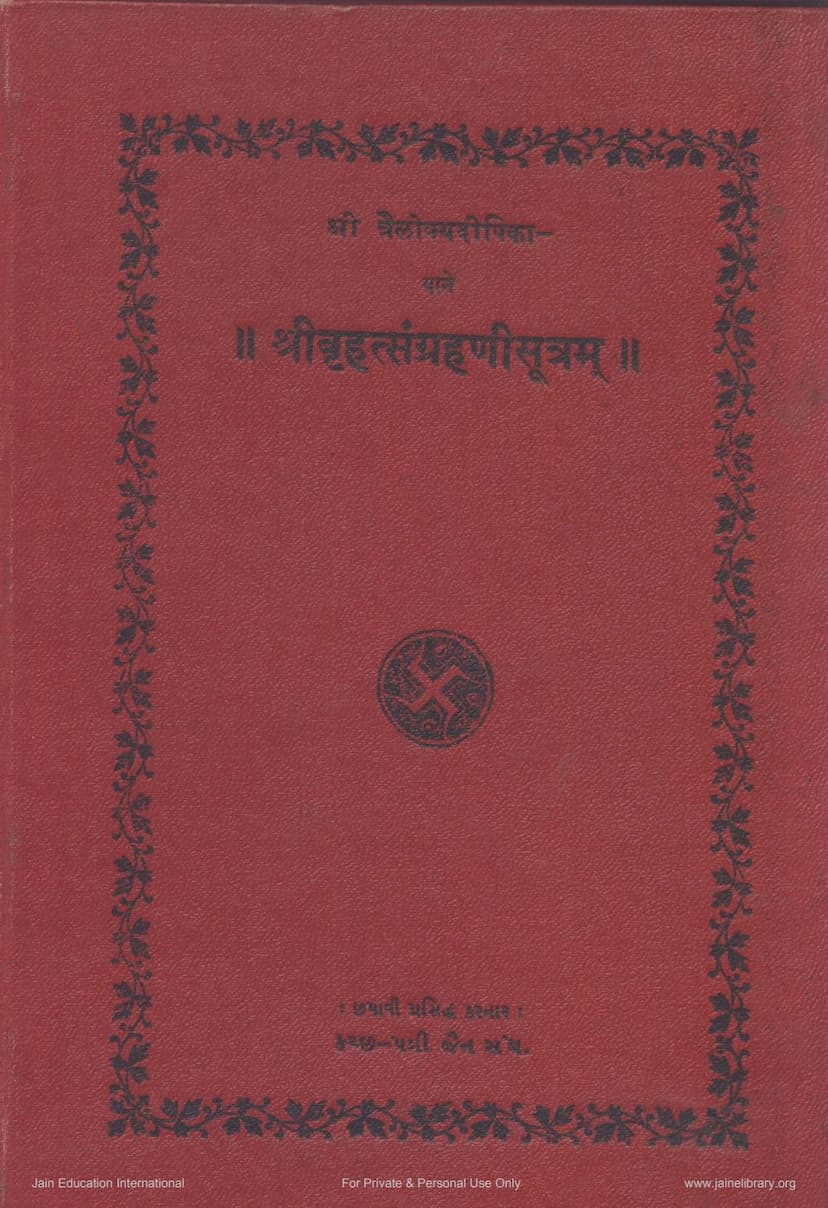Bruhat Sangrahani Sutram
Added to library: September 1, 2025

Summary
Summary of Bruhat Sangrahani Sutram by Deepvijay
The "Bruhat Sangrahani Sutram," authored by Deepvijay, is a comprehensive Jain text that meticulously details various aspects of the Jain cosmology and philosophy, primarily focusing on the classification and lifespan of celestial beings, hellish beings, humans, and animals. The text is a compilation and exposition of existing knowledge, aiming to provide a clear and accessible understanding of these complex subjects.
Here's a breakdown of the key themes and content covered in the Sutram:
1. Jain Cosmology and Classification:
- Jambu Dweepa and the Universe: The text begins by describing the structure of the Jain universe, detailing the concentric island continents (Dweepa) and oceans (Samudra), with Jambu Dweepa and its central Mount Meru being the focal point.
- Celestial Beings (Devas): A significant portion is dedicated to the various classes of celestial beings, including:
- Bhavanpatis (Palace-dwelling beings): Describes their ten classes, their respective Indras (kings), the number of their celestial abodes (Bhavana), their insignia, colors, clothing, and the number of Samanikas (attendants) and Ayudhakhyas (protectors).
- Vyavantaras (Intermediate beings): Details their eight classes, their Indras, abodes, insignia, colors, clothing, and attendant numbers.
- Jyotishis (Luminous beings): Explains the celestial bodies like the Sun, Moon, planets, and stars, their positions, movements, mansions (Vimana), their sizes, and the number of supporting celestial beings.
- Vaimanikas (Airborne celestial beings): This is a major focus, detailing the different classes of Vaimanikas residing in the heavens from Saudharma to Sarvartha Siddhi. It covers their lifespan (Ayushya), mansions (Vimana), their number, dimensions, colors, and the hierarchy of beings within these heavens. It also details the names and characteristics of the Indraka Vimanas.
- Hellish Beings (Naraka): The text meticulously describes the seven hellish realms (Naraka), their respective earth-layers (Prithivi), their lifespans (Ayushya) in ascending and descending order, the number of sub-layers (Pratara) in each hell, and the types of suffering and hellish abodes (Naraka-avasa) found there. It also details their physical characteristics and the specific hellish experiences they undergo.
- Humans (Manushya): Discusses the lifespan, body-height (Avagahana), birth, death, and transmigration of humans. It also delves into the lineage of great figures like Chakravartis, Vasudevas, Baladevas, and Arihantas, tracing their origins and destinies. The text enumerates the fourteen jewels of a Chakravarti and the seven jewels of a Vasudeva.
- Tiryanchas (Animals/Lower beings): Details the lifespan, body-height, and transmigration of various classes of Tiryanchas, including one-sensed beings (Ekendriya), two-sensed (Dvi-indriya), three-sensed (Tri-indriya), four-sensed (Chatur-indriya), and five-sensed (Panch-indriya) beings. It specifically mentions the lifespans and birthplaces of various types of Tiryanchas and their potential rebirths in different realms.
2. Key Jain Concepts and Principles:
- Ayushya (Lifespan): A central theme is the detailed calculation and classification of lifespans across all realms, using units like Sagaropama and Palyopama, and also specifying lifespans in years, months, days, and muhurtas for different beings.
- Bandha, Upakrama, Anupakrama (Karma and its effects): The text explains concepts related to karma, particularly how lifespan is bound (Bandha), how certain actions can shorten the experiential period of lifespan (Upakrama), and how the natural course of lifespan is unaffected by external factors (Anupakrama).
- Paryapti (Fulfillment/Development): The text discusses the stages of fulfillment in beings, particularly the five or six types of Paryapti (nourishment, body, senses, respiration, speech, and mind) that lead to full development.
- Prana (Vital Forces): It enumerates the ten vital forces that sustain life in different beings.
- Sanjna (Instincts/Consciousness): The ten types of instincts that guide the behavior of beings are outlined.
- Shatkhanda (Six Divisions): Concepts like the six types of Samghana (bone structures) and Samsthana (body shapes) are explained in relation to different classes of beings and their karmic predispositions.
- Leshya (Karmic Dispositions): The six types of Leshya (Kṛṣṇa, Nīla, Kāpota, Pīta, Padma, Śukla) are discussed in the context of their influence on the experiences of beings in different realms.
- Moksha (Liberation): While the primary focus is on the realms of existence, the ultimate goal of liberation is implicitly understood as the outcome of following the path of Ratnatrayi (Right Faith, Right Knowledge, Right Conduct).
3. Mathematical and Astronomical Calculations:
- Units of Measurement: The text utilizes specific units of time (Sagaropama, Palyopama) and space (Yojana, Hasta, Angula) and provides detailed explanations of their interrelationships.
- Mathematical Principles: The text implies the use of complex calculations, including multiplication, division, addition, and subtraction, to determine lifespans, distances, and the number of abodes.
- Astronomical Descriptions: The celestial movements of the Sun, Moon, planets, and stars are described in relation to the cosmic structure.
4. Structure and Compilation:
- Gathartha (Meaning of Verses): The text is presented with verses (Gatha) and their explanations, making it accessible to those who may not be experts in classical Jain literature.
- Compilation of Previous Works: The author acknowledges that the "Bruhat Sangrahani" is based on earlier, more extensive compilations by learned scholars. Deepvijay's work aims to present this knowledge in a more condensed and understandable format, especially for those with less intellectual capacity.
- Errata (Shuddhi Patrak): A list of corrections for printing errors is included, demonstrating the meticulous effort in presenting the text accurately.
In essence, the "Bruhat Sangrahani Sutram" serves as a foundational text for understanding the intricate details of Jain cosmology, providing a systematic and comprehensive guide to the various realms of existence and the beings that inhabit them. It highlights the Jain emphasis on karma, lifespan, and the cyclical nature of existence within a vast and complex universe.